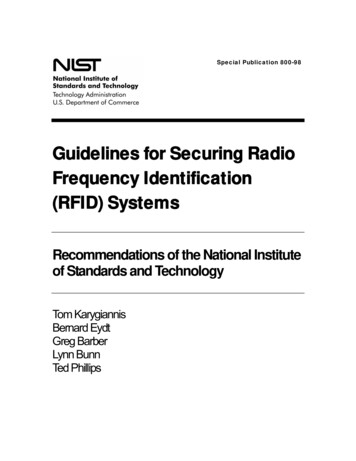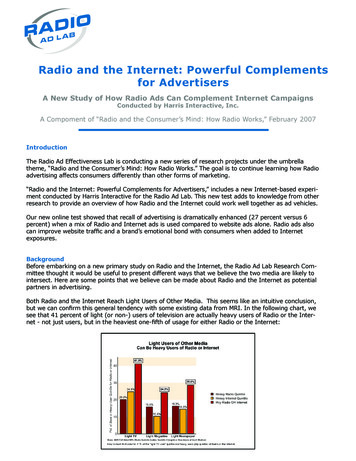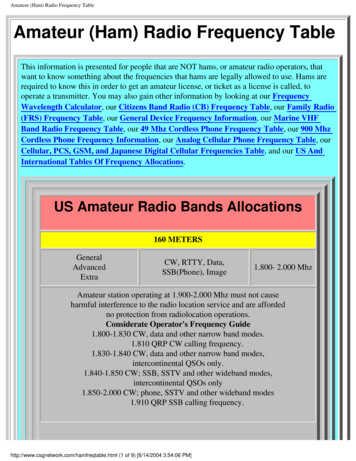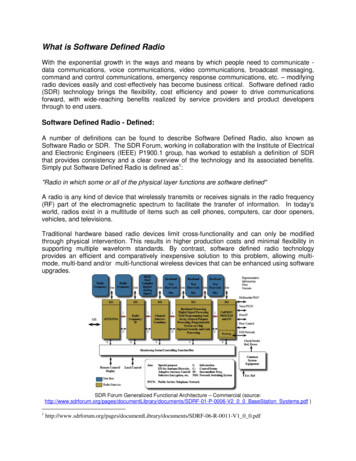
Transcription
Special Publication 800-98Guidelines for Securing RadioFrequency Identification(RFID) SystemsRecommendations of the National Instituteof Standards and TechnologyTom KarygiannisBernard EydtGreg BarberLynn BunnTed Phillips
NIST Special Publication 800-98Guidelines for Securing Radio FrequencyIdentification (RFID) SystemsRecommendations of the NationalInstitute of Standards and TechnologyTom KarygiannisBernard EydtGreg BarberLynn BunnTed PhillipsC O M P U T E RS E C U R I T YComputer Security DivisionInformation Technology LaboratoryNational Institute of Standards and TechnologyGaithersburg, MD 20899-8930April 2007US Department of CommerceCarlos M. Gutierrez, SecretaryTechnology AdministrationRobert C. Cresanti, Under Secretary of Commerce forTechnologyNational Institute of Standards and TechnologyWilliam Jeffrey, Director
GUIDELINES FOR SECURING RFID SYSTEMSReports on Computer Systems TechnologyThe Information Technology Laboratory (ITL) at the National Institute of Standards and Technology(NIST) promotes the US economy and public welfare by providing technical leadership for the nation’smeasurement and standards infrastructure. ITL develops tests, test methods, reference data, proof ofconcept implementations, and technical analysis to advance the development and productive use ofinformation technology. ITL’s responsibilities include the development of technical, physical,administrative, and management standards and guidelines for the cost-effective security and privacy ofsensitive unclassified information in Federal computer systems. Special Publication 800-seriesdocuments report on ITL’s research, guidelines, and outreach efforts in computer security and itscollaborative activities with industry, government, and academic organizations.National Institute of Standards and Technology Special Publication 800-98Natl. Inst. Stand. Technol. Spec. Publ. 800-98, 154 pages (April 2007)Certain commercial entities, equipment, or materials may be identified in thisdocument to describe an experimental procedure or concept adequately. Suchidentification is not intended to imply recommendation or endorsement by theNational Institute of Standards and Technology, nor is it intended to imply that theentities, materials, or equipment are necessarily the best available for the purpose.ii
GUIDELINES FOR SECURING RFID SYSTEMSAcknowledgmentsThe authors, Tom Karygiannis of NIST, and Bernard Eydt, Greg Barber, Lynn Bunn, and Ted Phillips ofBooz Allen Hamilton, wish to thank Steven Fick, Rick Korchak, Kate Remley, Jeff Guerrieri, DylanWilliams, Karen Scarfone, and Tim Grance of NIST, and Kenneth Waldrop and Beth Mallory of BoozAllen Hamilton. These individuals reviewed drafts of this document and contributed to its technicalcontent.The authors would also like to express their thanks to several experts for their critical review andfeedback on drafts of the publication. These experts include V.C. Kumar of Texas Instruments; SimsonGarfinkel of the Naval Postgraduate School; Peter Sand of the Department of Homeland Security; ErikaMcCallister of MITRE; and several professionals supporting Automatic Identification Technology (AIT)program offices within the Department of Defense (DoD), especially Nicholas Tsougas, Fred Naigle,Vince Pontani, Jere Engelman, and Kathleen Smith.During the public comment period we received helpful comments from the following FederalGovernment agencies: the US Departments of Defense, Health and Human Services, Homeland Security,Labor, and State; the Office of the Director of National Intelligence; the Office of Management andBudget; and the General Services Administration. We also received several helpful contributions fromcommercial industry, including comments from EPCglobal, VeriSign, and Priway.Finally, the authors wish to thank the following individuals for their comments and assistance: BrianTiplady, Daniel Bailey, Paul Dodd, Craig K. Harmon, William MacGregor, Ted Winograd, RussellLange, Perry F. Wilson, John Pescatore, Ronald Dugger, Stephan Engberg, Morten Borup Harning, MattSexton, Brian Cute, Asterios Tsibertzopoulos, Mike Francis, Joshua Slobin, Jack Harris, and JudithMyerson.iii
GUIDELINES FOR SECURING RFID SYSTEMSTable of ContentsExecutive Summary.ES-11.Introduction .1-11.11.21.32.RFID Technology.2-12.12.22.32.42.52.63.Automatic Identification and Data Capture (AIDC) Technology .2-1RFID System Components .2-2RF Subsystem .2-22.3.1 Tag Characteristics.2-32.3.2 Reader Characteristics .2-92.3.3 Tag-Reader Communication .2-12Enterprise Subsystem.2-142.4.1 Middleware .2-152.4.2 Analytic Systems .2-152.4.3 Network Infrastructure .2-16Inter-Enterprise Subsystem .2-172.5.1 Open System Networks.2-182.5.2 Object Naming Service (ONS).2-192.5.3 Discovery Service.2-21Summary.2-21RFID Applications and Application Requirements .3-13.13.23.33.43.53.64.Authority.1-1Purpose and Scope .1-1Document Structure .1-2RFID Application Types .3-13.1.1 Asset Management.3-23.1.2 Tracking.3-23.1.3 Authenticity Verification .3-33.1.4 Matching .3-33.1.5 Process Control .3-33.1.6 Access Control .3-43.1.7 Automated Payment .3-53.1.8 Supply Chain Management .3-5RFID Information Characteristics.3-6RFID Transaction Environment.3-73.3.1 Distance between Reader and Tag .3-73.3.2 Transaction Speed .3-83.3.3 Network Connectivity and Data Storage.3-8The Tag Environment between Transactions .3-93.4.1 Data Collection Requirements.3-93.4.2 Human and Environmental Threats to Tag Integrity.3-9RFID Economics .3-10Summary.3-11RFID Risks .4-14.14.2Business Process Risk .4-1Business Intelligence Risk .4-3iv
GUIDELINES FOR SECURING RFID SYSTEMS4.34.44.55.RFID Security Controls.5-15.15.25.35.46.Privacy Risk .4-4Externality Risk .4-64.4.1 Hazards of Electromagnetic Radiation .4-64.4.2 Computer Network Attacks.4-7Summary.4-8Management Controls.5-25.1.1 RFID Usage Policy .5-25.1.2 IT Security Policies .5-25.1.3 Agreements with External Organizations .5-35.1.4 Minimizing Sensitive Data Stored on Tags.5-4Operational Controls .5-45.2.1 Physical Access Control .5-55.2.2 Appropriate Placement of Tags and Readers .5-65.2.3 Secure Disposal of Tags .5-65.2.4 Operator and Administrator Training .5-75.2.5 Information Labels / Notice.5-75.2.6 Separation of Duties .5-85.2.7 Non-revealing Identifier Formats .5-85.2.8 Fallback Identification System .5-9Technical Controls .5-105.3.1 Authentication and Data Integrity .5-115.3.2 RF Interface Protection.5-155.3.3 Tag Data Protection.5-23Summary.5-26RFID Privacy Considerations.6-16.16.26.36.46.56.66.76.8Types of Personal Information .6-1The Applicability of Privacy Considerations to RFID Systems .6-2Privacy Principles.6-3Privacy Requirements for Federal Agencies.6-66.4.1 Privacy Act of 1974.6-66.4.2 E-Government Act of 2002 .6-76.4.3 Federal Information Security Management Act (FISMA) .6-86.4.4 Consolidated Appropriations Act of 2005 .6-86.4.5 Office of Management and Budget (OMB) Privacy Memoranda .6-9Health Insurance Portability and Accountability Act (HIPAA) of 1996 .6-9Federal CIO Council Privacy Control Families.6-10Industry Resources Addressing RFID Privacy .6-13Summary.6-147.Recommended Practices .7-18.Case Studies.8-18.1Case Study #1: Personnel and Asset Tracking in a Health Care Environment .8-18.1.1 Phase 1: Initiation .8-18.1.2 Phase 2: Acquisition/Development.8-28.1.3 Phase 3: Implementation.8-38.1.4 Phase 4: Operations/Maintenance .8-48.1.5 Phase 5: Disposition.8-4v
GUIDELINES FOR SECURING RFID SYSTEMS8.28.1.6 Summary and Evaluation .8-4Case Study #2: Supply Chain Management of Hazardous Materials .8-58.2.1 Phase 1: Initiation .8-58.2.2 Phase 2: Acquisition/Development.8-68.2.3 Phase 3: Implementation.8-68.2.4 Phase 4: Operations/Maintenance .8-78.2.5 Phase 5: Disposition.8-78.2.6 Summary and Evaluation .8-7List of AppendicesAppendix A— RFID Standards and Security Mechanisms . A-1A.1A.2A.3A.4International Standards. A-1Industry Standards. A-2Security Mechanisms in RFID Standards . A-3Proprietary Designs . A-5Appendix B— Glossary . B-1Appendix C— Acronyms and Abbreviations . C-1Appendix D— Information Resources . D-1Appendix E— FCC Exposure Limits . E-1Appendix F— Index . F-1List of FiguresFigure 2-1. An Example of a Simple RF Subsystem.2-3Figure 2-2. RFID Tag Printer .2-9Figure 2-3. Fixed Reader in Item Management Application.2-10Figure 2-4. Fixed Reader in Automatic Toll Collection Application .2-11Figure 2-5. Mobile Handheld Reader.2-11Figure 2-6. RFID System Architecture .2-15Figure 2-7. Inter-Enterprise Architecture.2-19Figure 5-1. Example 96-bit EPC .5-9Figure 5-2. Cover-Coding .5-16Figure 5-3. Grounded Metal Fencing as Shielding .5-19Figure 6-1. Taxonomy of Personal Information.6-1vi
GUIDELINES FOR SECURING RFID SYSTEMSList of TablesTable 2-1. Impact of Selected Materials on RF Transmissions, .2-7Table 2-2. Common Sources of RF Interference .2-7Table 2-3. Comparison of Traditional DNS and ONS Resolution Transactions.2-20Table 3-1. RFID Application Types .3-1Table 3-2. Economic Factors for Traditional IT Systems versus RFID Systems .3-10Table 4-1. Factors Influencing Business Process Risk.4-2Table 4-2. Factors Influencing Business Intelligence Risk.4-4Table 4-3. Factors Influencing Cyber Attack Risk .4-8Table 5-1. RFID Controls Summary.5-26Table 6-1. OECD Basic Principles: Guidelines on the Protection of Privacy and TransborderFlows of Personal Data .6-4Table 6-2. Federal CIO Council Privacy Control Families.6-10Table 7-1. RFID Security Checklist: Initiation Phase .7-3Table 7-2. RFID Security Checklist: Planning and Design Phase .7-6Table 7-3. RFID Security Checklist: Procurement Phase .7-9Table 7-4. RFID Security Checklist: Implementation Phase .7-11Table 7-5. RFID Security Checklist: Operations/Maintenance Phase .7-12Table 7-6. RFID Security Checklist: Disposition Phase .7-14Table 8-1. CRC Risk Management Strategy.8-4Table 8-2. RTA Risk Management Strategy .8-7Table A-1. EPC Identifier Formats . A-3Table A-2. Security Mechanisms in RFID Standards. A-4vii
GUIDELINES FOR SECURING RFID SYSTEMSThis page has been left blank intentionally.viii
EXECUTIVE SUMMARYExecutive SummaryLike any information technology (IT), radio frequency identification (RFID) presents security and privacyrisks that must be carefully mitigated through management, operational, and technical controls in order torealize the numerous benefits the technology has to offer. When practitioners adhere to sound securityengineering principles, RFID technology can help a wide range of organizations and individuals realizesubstantial productivity gains and efficiencies. These organizations and individuals include hospitals andpatients, retailers and customers, and manufacturers and distributors throughout the supply chain. Thisdocument provides an overview of RFID technology, the associated security and privacy risks, andrecommended practices that will enable organizations to realize productivity improvements whilesafeguarding sensitive information and protecting the privacy of individuals. While RFID security is arapidly evolving field with a number of promising innovations expected in the coming years, theseguidelines focus on controls that are commercially available today.RFID is a form of automatic identification and data capture (AIDC) technology that uses electric ormagnetic fields at radio frequencies to transmit information. An RFID system can be used to identifymany types of objects, such as manufactured goods, animals, and people. Each object that needs to beidentified has a small object known as an RFID tag affixed to it or embedded within it. The tag has aunique identifier and may optionally hold additional information about the object. Devices known asRFID readers wirelessly communicate with the tags to identify the item connected to each tag andpossibly read or update additional information stored on the tag. This communication can occur withoutoptical line of sight and over greater distances than other AIDC technologies. RFID technologies supporta wide range of applications—everything from asset management and tracking to access control andautomated payment.Every RFID system includes a radio frequency (RF) subsystem, which is composed of tags and readers.In many RFID systems, the RF subsystem is supported by an enterprise subsystem that is composed ofmiddleware, analytic systems, and networking services. RFID systems that share information acrossorganizational boundaries, such as supply chain applications, also have an inter-enterprise subsystem.Each RFID system has different components and customizations so that it can support a particularbusiness process for an organization; as a result, the security risks for RFID systems and the controlsavailable to address them are highly varied. The enterprise and inter-enterprise subsystems involvecommon IT components such as servers, databases, and networks and therefore can benefit from typicalIT security controls for those components.Implementing the recommendations presented in this publication should help organizations improve thesecurity of their RFID systems.Personnel responsible for designing RFID systems should understand what type of application anRFID system will support so that they can select the appropriate security controls.Each type of application uses a different combination of components and has a different set of risks. Forexample, protecting the information used to conduct financial transactions in an automated paymentsystem requires different security controls than those used for protecting the information needed to tracklivestock. Factors to consider include:The general functional objective of the RFID technology. For example, does the system need todetermine the location of an object or the presence of an object, authenticate a person, perform afinancial transaction, or ensure that certain items are not separated?ES-1
GUIDELINES FOR SECURING RFID SYSTEMSThe nature of the information that the RFID system processes or generates. One application may onlyneed to have a unique, static identifier value for each tagged object, while another application mayneed to store additional information about each tagged object over time. The sensitivity of theinformation is also an important consideration.The physical and technical environment at the time RFID transactions occur. This includes thedistance between the readers and the tags, and the amount of time in which each transaction must beperformed.The physical and technical environment before and after RFID transactions take place. For example,human and environmental threats may pose risks to tags’ integrity while the tagged objects are instorage or in transit. Some applications require the use of tags with sensors that can trackenvironmental conditions over time, such as temperature and humidity.The economics of the business process and RFID system. The economic factors for RFID systemsare different than those for traditional IT systems. For example, many RFID tags offer few or nosecurity features; selecting tags that incorporate basic security functionality significantly increases thecost of tags, especially if encryption features are needed. Also, the operational cost of some basic ITsecurity controls, such as setting unique passwords and changing them regularly, may be higher forRFID systems because of the logistical challenges in managing security for thousands or millions oftags.For RFID implementations to be successful, organizations should effectively manage their risk.Like other technologies, RFID technology enables organizations to significantly change their businessprocesses to increase efficiency and effectiveness. This technology is complex and combines a number ofdifferent computing and communications technologies. Both the changes to business process and thecomplexity of the technology generate risk. The major risks associated with RFID systems are asfollows:Business process risk. Direct attacks on RFID system components potentially could undermine thebusiness processes the RFID system was designed to enable. For example, a warehouse that reliessolely on RFID to track items in its inventory may not be able to process orders in a timely fashion ifthe RFID system fails.Business intelligence risk. An adversary or competitor potentially could gain unauthorized access toRFID-generated information and use it to harm the interests of the organization implementing theRFID system. For example, an adversary might use an RFID reader to determine whether a shippingcontainer holds expensive electronic equipment, and then target the container for theft when it gets apositive reading.Privacy risk. Personal privacy rights or expectations may be compromised if an RFID system useswhat is considered personally identifiable information for a purpose other than originally intended orunderstood. As people possess more tagged items and networked RFID readers become ever moreprevalent, organizations may have the ability to combine and correlate data across applications toinfer personal identity and location and build personal profiles in ways that increase the privacy risk.Externality risk. RFID technology potentially could represent a threat to non-RFID networked orcollocated systems, assets, and people. For example, an adversary could gain unauthorized access tocomputers on an enterprise network through Internet Protocol (IP) enabled RFID readers if thereaders are not designed and configured properly.ES-2
EXECUTIVE SUMMARYOrganizations need to assess the risks they face and choose an appropriate mix of management,operational, and technical security controls for their environments. These organizational assessmentsshould take into account many factors, such as regulatory requirements, the magnitude of each threat, andcost and performance implications of the technology or operational practice.Privacy regulations and guidance are often complex and change over time. Organizations planning,implementing, or managing an RFID system should always consult with the organization’s privacyofficer, legal counsel, and chief information officer.When securing an RFID system, organizations should select security controls that are compatiblewith the RFID technologies they currently deploy or purchase new RFID technologies that supportthe necessary controls.To be most effective, RFID security controls should be incorporated throughout the entire life cycle ofRFID systems—from policy development and design to operations and retirement. However, manyRFID products support only a fraction of the possible protection mechanisms. Tags, in particular, havevery limited computing capabilities. Most tags supporting asset management applications do not supportauthentication, access control, or encryption techniques commonly found in other business IT systems.RFID standards specify security features including passwords to protect access to certain tag commandsand memory, but the level of security offered differs across these standards. Vendors also offerproprietary security features, including proprietary extensions to standards-based technologies, but theyare not always compatible with other components of the system. Careful planning and procurement isnecessary to ensure an organization’s RFID system meets its security objectives.ES-3
GU
RFID S. YSTEMS. Re. ports on Computer Systems Technology . The Information Technology Laboratory (ITL) at the National Institute of Standards and Technology (NIST) promotes the US economy and public welfare by providing technical leadership for the nation's measurement and standards infrastructure. ITL develops tests, test methods, reference .











